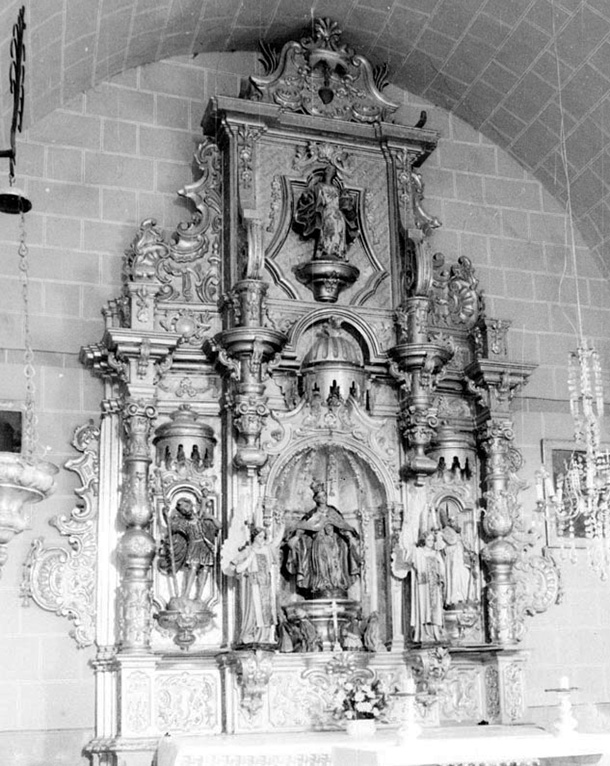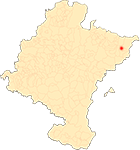Route through the Roncal altarpieces
By Ricardo Fernández Gracia
Altarpiece of the Shrine of Our Lady of Fair Love de Nuestra Señora del sponsorship of Uztárroz
For this new Shrine of Our Lady of Fair Loveerected in 1756, the main altarpiece was made by the master Miguel Ayerdi, who completed it in 1762. The aforementioned author had years before made the organ case of the parish church of Isaba (1751), the choir stalls of Vidángoz (1759) and had competed with Francisco Nicolás Pejón for the award of the collateral, the Virgin of the Rosary of Roncal (1754), who ended up winning the contract.
The moving lines of the altarpiece, as well as the balustraded supports, link it to models from the Rococo period and relate it to works by Francisco Nicolás Pejón. Its design consists of a bench with pedestals, a three-aisle body articulated by balusters and suspended capitals and an attic of designmixtilinear between buttresses with flutings. The Virgin of sponsorshipis the best of its imagery and together with the Virgin of La Merced in Tudela is the only case we know of in which the image of Mary appears with small figures imploring, like donors, on a small scale under her feet. The side streets are occupied by Saint Christopher and a saintly bishop, while the attic is presided over by a martyred saint, probably Saint Engracia, the patron saint of the parish. At the top there is a relief with the image of the Sacred Heart.
The titular image was brought from the Aragonese capital and is one of the few examples of this devotion in Navarre, as only in Milagro, Oteiza and Sumbilla are there images of the Virgin under this title degree scroll. However, the one in Uztárroz is the only one of them all that adapts to the iconography of the aforementioned dedication, with the mantle unfolded to welcome in this case a knight in an 18th-century coat, a pope, a king and a canon, all of them kneeling. The origin of the topicof the Virgin of sponsorshipor of Mercy is perhaps to be found in a passage of the Dialogus miraculorum, written around 1220 by the Cistercian monk Cesarius of Heisterbach, in which he narrates the vision of a monk who saw the Cistercian order in the kingdom of heaven under the mantle of Mary. From this vision onwards, different versions of the figurative arts would follow in order to express the effect of the Virgin's mercy on her favourite children. From the Cistercians it would pass to other religious orders and from these to confraternities, to the faithful in general, to sinners and to the souls in purgatory. Mary's mantle became a protector and shelter for believers, in the same way that when a child was legitimised or adopted, it was solemnly covered with it.
Renaissance and Baroque Spanish painting abounds with the topicof the sponsorshipof the Virgin, as can be seen in the outstanding examples of El Greco's Virgin of Mercy, Alejo Fernández's Virgin of the Navigators and Zurbarán's Virgin of the Carthusians. It was a graphic way of showing that a cathedral chapter, a high school, a community or a people placed themselves under the protection of the Virgin in her multiple invocations, or under that of a saint, particularly Saint Joseph. The aim was to obtain a remedy for a need or protection through her intercession and protection before God.
Parish archives of Garde, Vidángoz, Isaba, Uztárroz and Roncal.
file Diocesan of Pamplona. Processes
file General of Navarre. Roncal Notary's Office and Processes
ARDANAZ IÑARGA, N., La catedral de Pamplona en el siglo de las Luces. Arte, ceremonial y cultura, Pamplona, doctoral dissertation sustained at the University of Navarre, 2011. Vid. http://hdl.handle.net/10171/20480
BOLOQUI LARRAYA, B., Escultura zaragozana en la época de los Ramírez 1710-1780, Madrid, Ministerio de Cultura, 1983.
CHOCARRO HUESA, M., "El obispo Juan Rena, mediador y mecenas artístico de la catedral de Pamplona", Príncipe de Viana, 256 (2012), Issue dedicated to: programs of study sobre el Patrimonio Cultural y las artes en Navarra en torno a tres hitos 1212-1512-1812, (coordinated by Ricardo Fernández Gracia), pp. 587-601.
CLAVERÍA ARANGUA, J., Iconografía y santuarios de la Virgen en Navarra, vol. I, Madrid, Gráfica management assistant, 1942.
ECHEVERRÍA GOÑI, P., Polychromy of the Renaissance in Navarre, Pamplona, Government of Navarre, 1990.
GARCÍA GAÍNZA, M. C., Romanesque sculpture in Navarre. Disciples and followers of Juan de Anchieta, Pamplona, 1969.
GARCÍA GAÍNZA, M. C. et alt., Catalog Monumental de Navarra, IV* y IV**. Merindad de Sangüesa, Pamplona, Government of Navarra - Archbishopric of Pamplona - University of Navarra, 1989 and 1992.
FERNÁNDEZ GRACIA, R., El retablo barroco en Navarra, Pamplona, Government of Navarre, 2003.
FERNÁNDEZ GRACIA, R., "Los géneros escultóricos", El arte del Barroco en Navarra, (coord. R. Fernández Gracia), Pamplona, Gobierno de Navarra, 2014, pp. 175-271.
GÁRRIZ, J., La villa de Garde en el Valle del Roncal. essay de una monografía parroquial, Pamplona, Casa publishing house de G. Huarte, 1923.
HUALDE, F., "De cuando los Ezquer cruzaron el charco", Diario de Noticias de Navarra, 18 August 2008. http://patrimonionavarra2.blogspot.com.es/2010/09/18-de-agosto-de-2008.html
MORALES SOLCHAGA, E., "El gremio de San José y Santo Tomás de Pamplona hasta el siglo XVII", Príncipe de Viana, no. 239 (2006), pp. 791-860.
URANGA, J. E., Retablos navarros del Renacimiento, Pamplona, Institución Príncipe de Viana, 1947.












